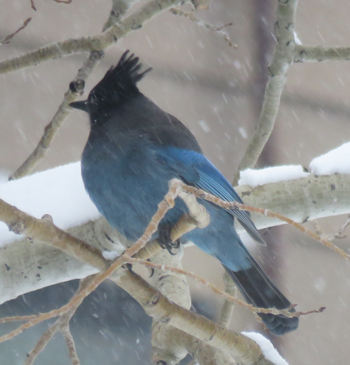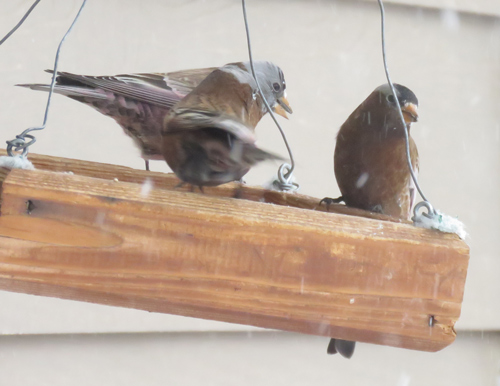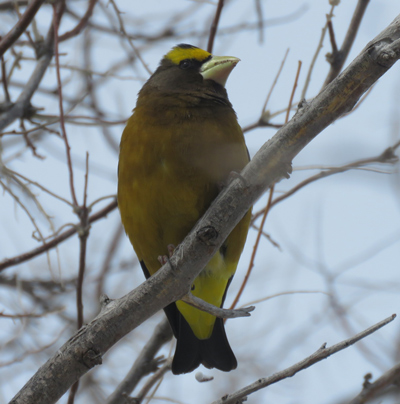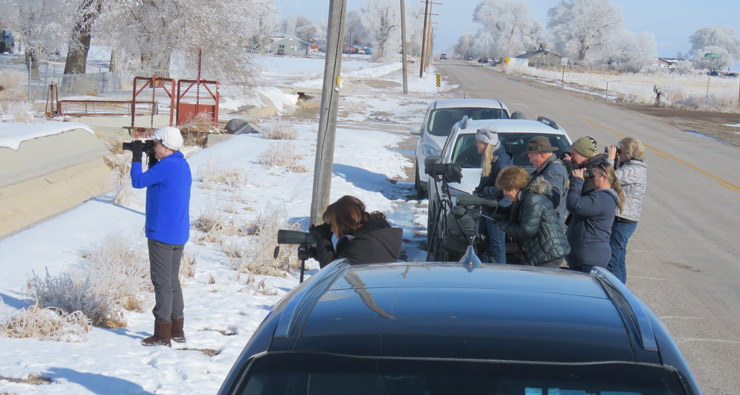Utah County Birders Newsletter
|
|||||||||||||||||||||||||||||||||||||||||||||||||||
 |
Contents
March Meeting
Upcoming Field Trips
Captain's Log
Bird of the Month
Field Trip Reports
Thursday, March 8, 2018, 7pm at the Monte L. Bean Museum in Provo, UT.
Sam Braegger, Outreach Coordinator, Utah Lake
Commission will be our guest speaker this month. What is the
Utah Lake Commission? What are they doing with the State Park? How is the Utah
Delta Restoration Project
coming along? How can the UCB connect with Utah Lake and the Utah Lake Festival?
Sam will answer all these
questions and more! Come join us for an interesting and informative meeting.
Saturday March 10, 2018: Provo Canyon/South Fork/Sundance Field Trip. Letís go see the American Dipper and find a Northern Pygmy Owl! Meet at the 800 N. Orem Harmonís Parking lot by the gas pumps at 9am. Led by Suzi Holt
Saturday March 24, 2018:
Emma Park Road/Scofield Greater Sage-grouse Field Trip. Meet at 6am in the SE
corner of the Chevron parking lot at the mouth of Spanish Fork Canyon. Take the
Hwy 6 Price exit on I-15, and
drive to the mouth of Spanish Fork Canyon. Come experience a Greater Sage-grouse
lek
We are actively recruiting people to lead local half-day field
trips, any time, any place. If you would like to lead a field trip or if you
have any ideas for this yearís field trips, please contact Suzi Holt at -
suzerqholt@gmail.com
Utah County Birders
Captainís Log: March
2018
by Keeli Marvel
I was really hoping I would have awesome news about getting a lifer snowy owl,
but alas, I spent the better part of
an afternoon driving around rural Colorado southwest of Ft. Collins not finding
a snowy owl. I found lots of other
raptors - a surprising number actually - but no owl. And so here I sit,
reporting a lack of snowy owl in my life. What
a grim tale.
Since we are on the topics of grim things, I want to talk about something a
little grimmer. On the field trip last
weekend Machelle and I found a Golden Eagle that had been hit by a car. Road
strikes are an unfortunate and
increasingly common cause of raptor mortality, and likely a result of birds
attracted to and feeding on other road
kill on the roads. Little is known currently about the rates at which road
strikes occur, however, Hawk Watch, a
nonprofit science-based conservation organization has been collecting data
regarding road kill raptors
(specifically owls and eagles). If you happen to see one, take pictures, record
the location (a GPS coordinate if
you've got it) and email it in to Hawk Watch's conservation science department.
I did all of that with the eagle
Machelle and I found, in addition to dragging it off the road to prevent any
other carrion feeders from also being
hit. It's not a pleasant topic to deal with but this kind of data may help us
better understand and address causes of
population decline in raptor species and help further conservation efforts-
something I think we can all get behind.
As most of you know, Golden Eagles are federally protected by the Bald and
Golden Eagle Protection Act
(BGEPA). Much of what I do at work deals with implementation of this act and
deconfliction with military activities.
The gist of BGEPA is that Eagles are protected from any disturbance that affects
them going about living their
lives. Their nests are protected year round, and even after death, all parts of
a dead eagle are protected. You
cannot have in your possession at any time any part of an eagle, its' nest, or
eggs, without a federal permit
specifically giving you permission to do so. There is a national repository
where dead eagles can be sent where
Native American tribes have access to them for traditional tribal uses. However,
the possession and sending and
every part of that process is heavily regulated by the US Fish and Wildlife
Service (the regulatory authority over
the BGEPA).
As you may also remember, migratory birds (which includes everything else that's
not an eagle, (migratory or not),
except European Starlings, House Sparrows, and Rock Pigeons. All species
protected under the Migratory Bird
Treaty Act are protected in much of the same way as eagles in that all parts of
migratory birds (feathers, eggs,
etc...) are protected and you may not possess any part of a migratory bird
without a permit from the USFWS.
However, unlike eagles, the nests of migratory birds are not protected when they
are not in use.
Last week one of our colleagues at work found a road strike dead golden eagle in
good enough shape that we
picked it up (officially sanctioned by the US Fish and Wildlife Service Field
Office), and we will be coordinating
with the state to ship it to the national repository hopefully for future tribal
use.
I know this is a little bit more of a grim topic, but I hope it was informative.
Next month, I promise I'll talk about
something a little more cheerful!
With that, I hope you all are enjoying this brief return to winter that we've
been having, and I wish you all safe and
happy birding!
by Yvonne Carter
Last month there was a lot of excitement happening for birders in our area. Not only was there the Yellow-bellied Sapsucker in the Payson Cemetery, but three species of owls! One of which was the Northern Saw-whet Owl. This brought out a lot of birders with good looks and views.
The Northern Saw-whet Owl is one of the small owl species which are usually
found in mixed coniferousdeciduous
woods. So our Payson Cemetery fit the terrain perfectly. 'A place everyone is
dying to go' They cohabitat with Western Screech-Owls and Flammulated Owls,
smaller than the Western but larger than the Flammulated. Even though they
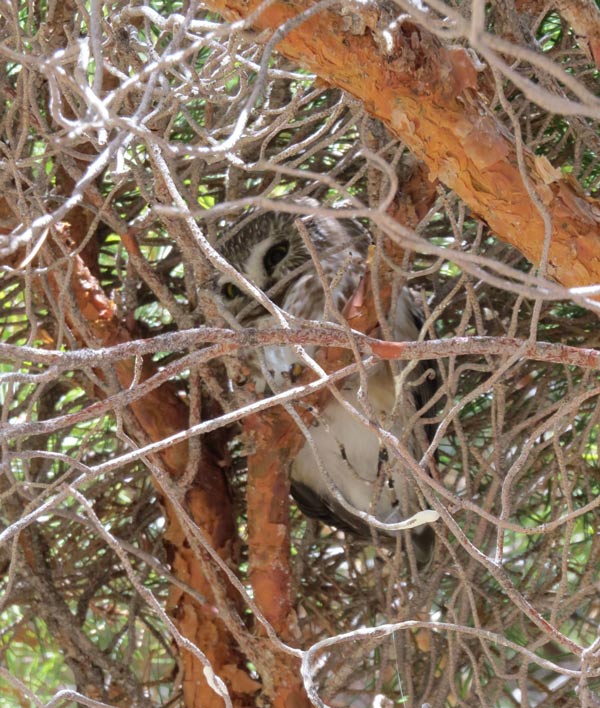 |
|
Photo credit: Cliff Miles, Payson Cemetery |
are smaller than the Western Screech-Owl and the Boreal Owl they have longer wings than the Boreal but a shorter tail. The Saw-whet is rounder, more petite and considered cuter than a screech owl. So cute as to 'put it in your pocket and take it home with you'.
The head of the Northern Saw-whet is somewhat heartshaped and tuftless. With its
chunky body and stub of a tail, the overall shape and size resembles an avocado.
The facial disk is pale brown, with a white 'V' or white triangle stamped
between the yellowish eyes on its forehead. The pale breast is boldly streaked
with chestnut brown. And in the adult there are distinct white braces on the
back and brown streaking below.
In flight, their wingspan is about 17 inches, flying generally
low and direct and the wingbeats are quick and entirely below horizontal and
silent as it approaches its prey. It hunts only at Photo credit: Cliff Miles,
Payson Cemetery
night, roosts by day which is usually when most observers see them. It usually
roosts away from tree trunks and
not more than 12 ft. above the ground. It also commonly uses the same perch
night after night.
Its song are a repeated, low, whistled toots similar to the Northern Pygmy-Owl
but with a regular rhythm.
Recently, there have been comments made regarding whether or not to let others
know of the location of owls for
conservation purposes. But with this recent episode with the owls in Payson
Cemetery, I would like to share my
observation. On a Saturday afternoon with several of our birders observing the
Northern Saw-whet as it roosted
in a tree, a family was leaving a funeral. And noticing our group looking up at
the owl, the young boys with their
grandparents walked over to observe this darling little owl. In the process, we
talked to them about this bird and
how we should stand back and admire and not disturb it. Hopefully, they learned
a great lesson in the wonders
of this earth and its creatures, which can only be learned by participating.
References: Pete Dunne's Essential Field Guide Companion, Sibley Field Guide and
National Geographic Field
Guide.
Click here for past 'Birds of the Month'.
|
Field Trip Reports |
|
|
Alta Feeders Field Trip - 10 Feb 2018 by Suzi Holt |
|
| Alta
feeders field trip was a success! Hairy Woodpecker, Clark's Nutcracker,
Gray-crowned Rosy Finch, Stellar's Jay, Pine Siskin and Ravens! Good times!
Thanks to all who came :-) |
|
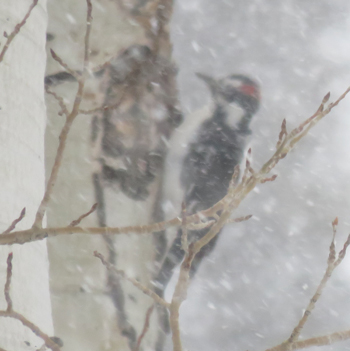 |
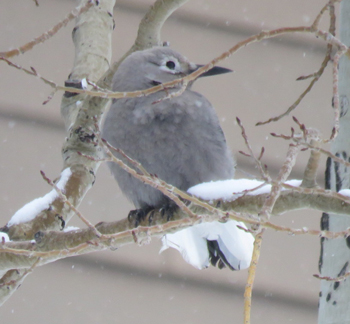 |
| Pine Siskin |
Steller's Jay |
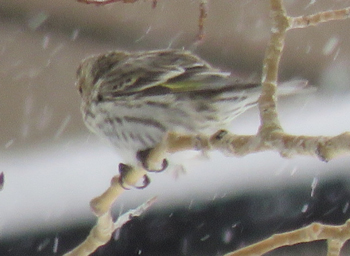 |
|
| Pine Siskin |
Steller's Jay |
|
|
|
|
Rosy-Finches |
|
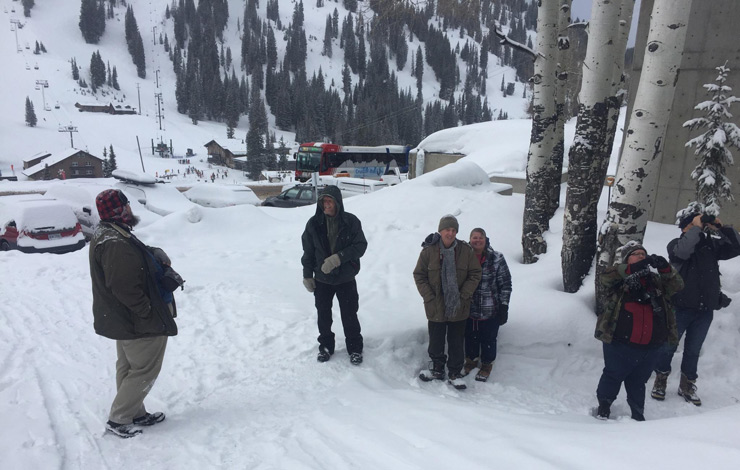 |
|
|
Birders at Alta |
|
|
Delta Snow Goose Festival - 24 Feb 2018 by Suzi Holt |
|
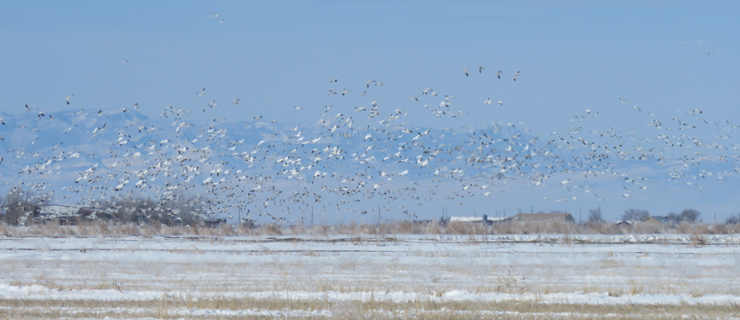 |
|
| A great day for a trip to the Delta Snow Goose Festival!!! We saw tons of Snow Geese and a few Ross's Geese even though the reservoir was all ice, we found them by the thousands in the fields. | 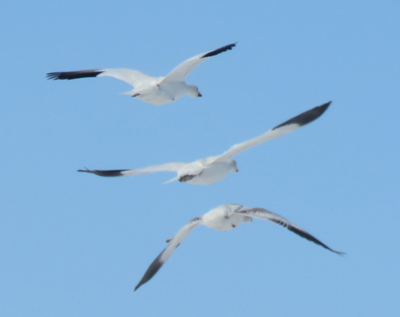 |
| We also saw Canada Geese, hundreds of Horned Larks, Golden Eagles, Red-tailed and Rough-legged Hawks, Blackbirds, House, Song and White-crowned sparrows, lots if Juncos, Kestrals, Flickers, Great-tailed Grackle, Mallards, Green-winged Teal, Cinnamon Teal, American Wigeons, Northern Pintails, Tundra Swan, Mountain Bluebirds, Evening Grosbeaks, Sharpie, Spotted Towhees, Ring-necked Pheasant, Killdeer, and many Robins :-) | |
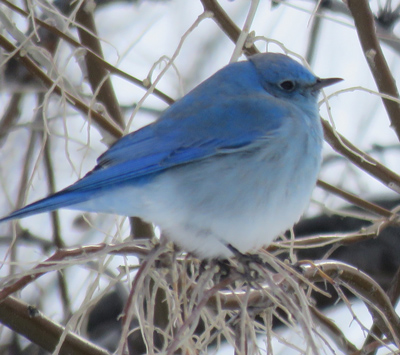 |
|
|
Mountain Bluebird |
Evening Grosbeak |
| And to top it off a birthday party on Warm Springs Road for Jeremy Telford with Ross's and Snow Goose balloons from the Balloon Guy himself! | 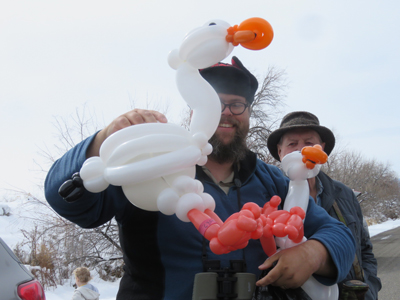 |
|
Jeremy Telford -- Balloon and
Birthday guy! |
|
|
|
|
|
Birders at the Snow Goose Festival |
|
Printable Version of this UCB Newsletter
